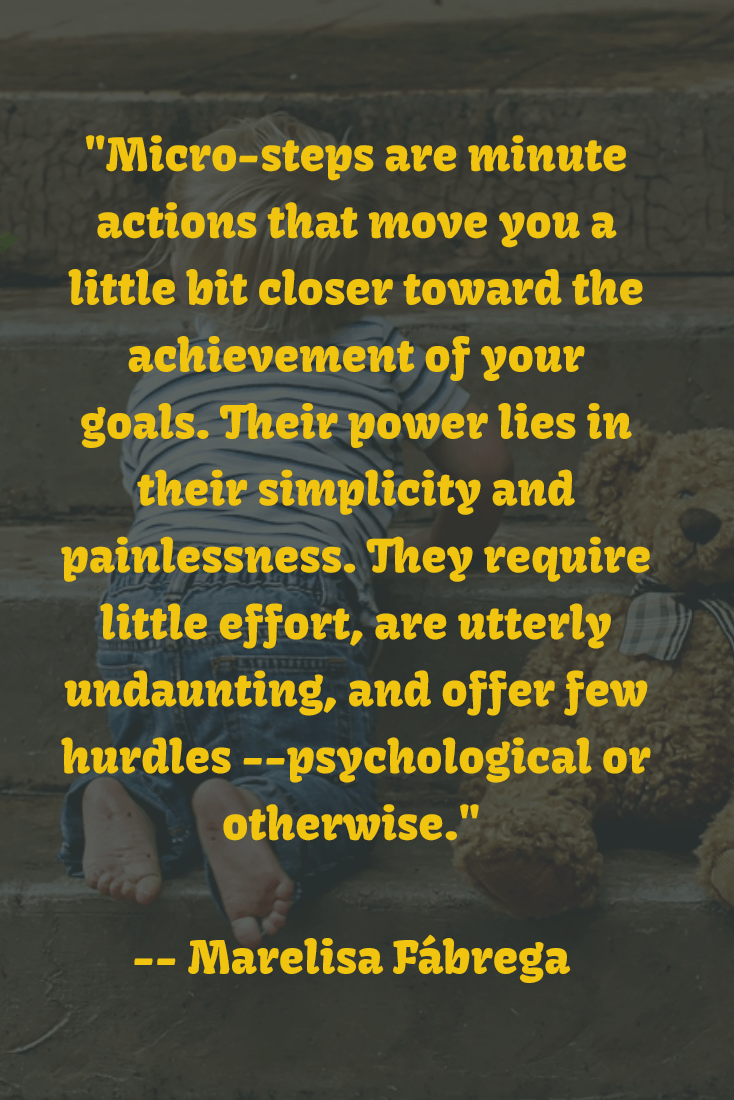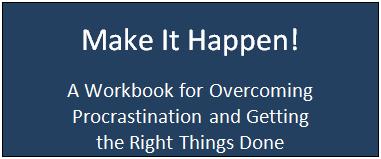
Sometimes the best way forward isn’t by leaps and bounds, but by taking micro-steps.
What comes to mind when you hear the word “micro”? Probably the following: extremely small; minute quantities or variations; or tiny. Micro-steps are exactly what the name implies:
“Micro-steps are minute actions that move you a little bit closer toward the achievement of your goals. Their power lies in their simplicity and painlessness. They require little effort, are utterly undaunting, and offer few hurdles–psychological or otherwise.” — Marelisa Fábrega
In this post I’m going to explain to you how micro-steps can help you to achieve even your boldest and most audacious goals.
How to Harness the Power of Micro-Steps
When trying to achieve your goals, you’ve probably faced the following challenges:

- A lack of time.
- Your willpower fails you.
- That pesky inner critic keeps sabotaging your efforts.
- You just can’t get started, no matter how hard you try.
- Money is an issue.
- You find yourself in the grips of procrastination.
- The motivation that you need to get started is nowhere to be found.
All of these challenges can be overcome by taking micro-steps. The way to take micro-steps is to choose one of the following (or combine two or more of them):
- Make your goals exceedingly doable by setting micro-goals.
- Set money aside for your goals by microsaving.
- Make progress on your goals with micro-progressions.
- Build the habits that are necessary to achieve your goals by adopting micro-habits.
There’s more on each of these below.
Set Micro-Goals
The first way to use the power of micro-steps to your advantage is by setting micro-goals. You’ve probably heard about BHAGs — Big Hairy Audacious Goals. This is a term that was coined by James Collins and Jerry Porras. Although I’m a big proponent of setting BHAGs, trying to achieve a BHAG is hard–because they’re big, and they’re hairy.
That’s where micro-goals come in. Here are the benefits of setting micro-goals:
- Because micro-goals are so small, they’re–by definition–realistic.
- You can easily get yourself to believe that you can achieve a micro-goal. As an illustration, it may be hard for you to believe that you can make a full-time living online, but you can probably get yourself to believe that you can make $1 online.
- Each time you achieve a micro-goal, you feel like you’re making progress. That motivates you to pursue the next micro-goal, and then the next, and then the next. In time, those micro-goals will add up and you’ll have achieved one of your important life goals (one of your BHAGs).
- You’ll be happier if you set micro-goals. Harvard Business Review researchers found that taking small steps allows you to experience a sense of progress more frequently, and this has been linked to greater happiness.
How to Set Micro-Goals
How do you set micro-goals? Easy: choose one of your important life goals and break it down into the tiniest goals you can think of. Here are three examples:
- Do you want to lose 30 pounds? Start off by setting the micro-goal of losing one pound. One, little, measly pound.
- What if you currently wake up at 8:00 a.m. but you want to join the 5 AM Club? Instead of setting the goal of waking up at 5:00 a.m., set the micro-goal of waking up at 7:55 a.m.
- Do you want to declutter your home? Set the micro-goal of decluttering your kitchen junk drawer.
A micro-goal is so small, you can easily trick your brain into getting started. In addition, it’s so insignificant, your inner critic is likely to let it slip by without even uttering a disapproving “hmpff”. Finally, it’s over so fast, an ounce of motivation is all your need to achieve your micro-goal.
The first micro-step you should take is to set a micro-goal.
Make Microsavings
Saving money is hard–the average person has many expenses, and there are just so many things you could buy (I almost bought some crunchy slime just now, which I would have used once or twice). In addition, many goals cost money, which means that you need to save for them.
Here are three examples of the costs that are associated with different goals:
- If your goal is to build strength by lifting weights, you have to save up for a gym membership.
- You could set the goal of taking great photos during your upcoming trip to Paris. If that’s the case, you have to buy a camera and the photography gear that you’ll need (the right lens, extra batteries, a case for your camera, and so on).
- What if your goal is to participate in the most scenic 10-kilometer races in the country? Then you have to save up for travel expenses.
You can set aside the money that you need in order to achieve your goals by using the concept of microsaving.
How to Start Microsaving
Microsaving consists of saving a little bit of money here and there. So little, that you barely feel it. Over time, these little bits of money add up.
One way to microsave is by downloading a microsaving app. These apps use artificial intelligence to analyze your spending. Then, they starts taking a little bit of money from your checking account here and there, and depositing those amounts in a savings account. And they do this in a way that will have very little impact on you.
If you spend little one week, the app that you choose will take more money from your account that week and save it for you. But if you overspend on another week, no money will be saved by the app that week. Drop by drop, money will be saved for you, and you will barely realize that it’s happening.
Of course, another way to microsave is by using an old-fashioned glass jar. Every day when you get home at night, simply place any loose change you have in your pockets, or in your wallet, in the jar. Then, watch how the jar slowly fills up.
Microsaving is yet another way to take advantage of the power of micro-steps.
Create Micro-Habits
One of the best ways to achieve an important goal is by turning the actions you need to take in order to achieve that goal into habits. Here are three examples:
- If you want to lose weight, you need to create the habit of exercising on a regular basis.
- To start a blog, you need to create the habit of writing on a regular basis.
- If you want to acquire a new skill, you need to practice consistently.
All those who have tried adopting a new habit and failed now how hard it can be to acquire good habits. That’s where micro-habits come in. A micro-habit is an action that requires minimal effort and may appear to be inconsequential, but which slowly builds up to something meaningful.
As an illustration, suppose that you want to adopt the habit of walking on your treadmill for half-an-hour before work. You can begin by creating the micro-habit of standing on your treadmill for a few minutes as you drink your morning coffee and watch the news.
This micro-habit may seem like a total waste. You’re not even moving. Ahh. . . but once you’ve been standing on the treadmill for a few mornings, you can adopt the micro-habit of walking for one minute.
A while later you can decide to create the micro-habit of walking for five minutes. Maybe two weeks after that you decide to create the micro-habit of walking for seven minutes. Each micro-habit brings you one step closer to the habit of walking for half-an-hour before work. Sweet!
Make Micro-Progressions
Making progress toward an important goal means that you’re moving closer to the achievement of that goal. You can progress quickly, or slowly. If you progress quickly, you’ll achieve your goal sooner. However, it’s not always possible to progress quickly. Here’s why:
- It requires more effort to make quick progress.
- You may not be able to muster the motivation and the willpower necessary to make great strides forward.
- There may be other things competing for your time and attention.
- Progressing at a fast pace may be seem scary.
- It could be that you simply don’t have the physical or mental capacity to make fast progress.
If you find that you can’t make quick progress, make slow progress. In fact, you can even make micro-progressions; progress that is so slow, it’s almost effortless.
An Example of Micro-Progression: Weightlifting
I’m going to use myself as an example of how to use micro-progressions to achieve your goals. As I’ve said before on this blog, I’m a weightlifter. When you first start lifting weights, you begin with light weights–I started with the pink 5-pound dumbbells. However, you gradually progress by lifting heavier weights.
Lifting heavier weights is relatively easy, up to a certain point. Once you reach your genetic potential, lifting heavier weights gets harder. When that happens, it becomes more difficult to make progress.
That’s where micro-progression comes in. The smallest weightlifting plates at my gym weigh 2.5 pounds. This means that each time I want to make progress, I have to go up by 5 pounds (one 2.5 pound plate on each side of the bar). I’ve reached a weight at which this is really hard for me.
Therefore, I went on Amazon and bought myself 0.5 pound plates. Now, I simply put one 0.5 pound plate on each side of the bar and go up by one pound at a time. That’s a micro-progression. It’s progress that requires very little mental and/or physical effort on my part.
An added bonus of microprogressions is that you get a hit of dopamine each time you make progress on a goal. Here’s a tweet I sent out the other day:
One of the things I love about weightlifting is that every week you can break your PR – Personal Record. All you have to do is lift a little bit more than you did the last time. 🏋️♀️😎
— Marelisa Fabrega (@Marelisa) May 9, 2019
In my post, How to Increase Dopamine to Skyrocket Your Motivation, I wrote that having high levels of dopamine in your brain leads to motivation. As I’ve already stated, each micro-progression increases the levels of dopamine in your brain, which will motivate you to make the next micro-progression.
If you’re having trouble making progress on an important goal, ask yourself what micro-progression you can make. Think of something that would be the equivalent of a 0.5 pound plate (seriously, they’re tiny and really light).
By making micro-progressions you’ll be moving toward your goal slowly, but you’ll be advancing, instead of standing still.
Conclusion
What do you think of the “micro” approach to achieving your goals? It requires little willpower, little motivation, and little effort. Try it! You may be amazed at what you achieve. Live your best life by taking micro-steps.






Related Posts:




 Marelisa Fabrega is a lawyer and entrepreneur. She holds a Bachelor of Science in Business Administration from Georgetown University in Washington, D.C., as well as a Juris Doctor from the Georgetown University Law Center. You can learn more about her
Marelisa Fabrega is a lawyer and entrepreneur. She holds a Bachelor of Science in Business Administration from Georgetown University in Washington, D.C., as well as a Juris Doctor from the Georgetown University Law Center. You can learn more about her 





